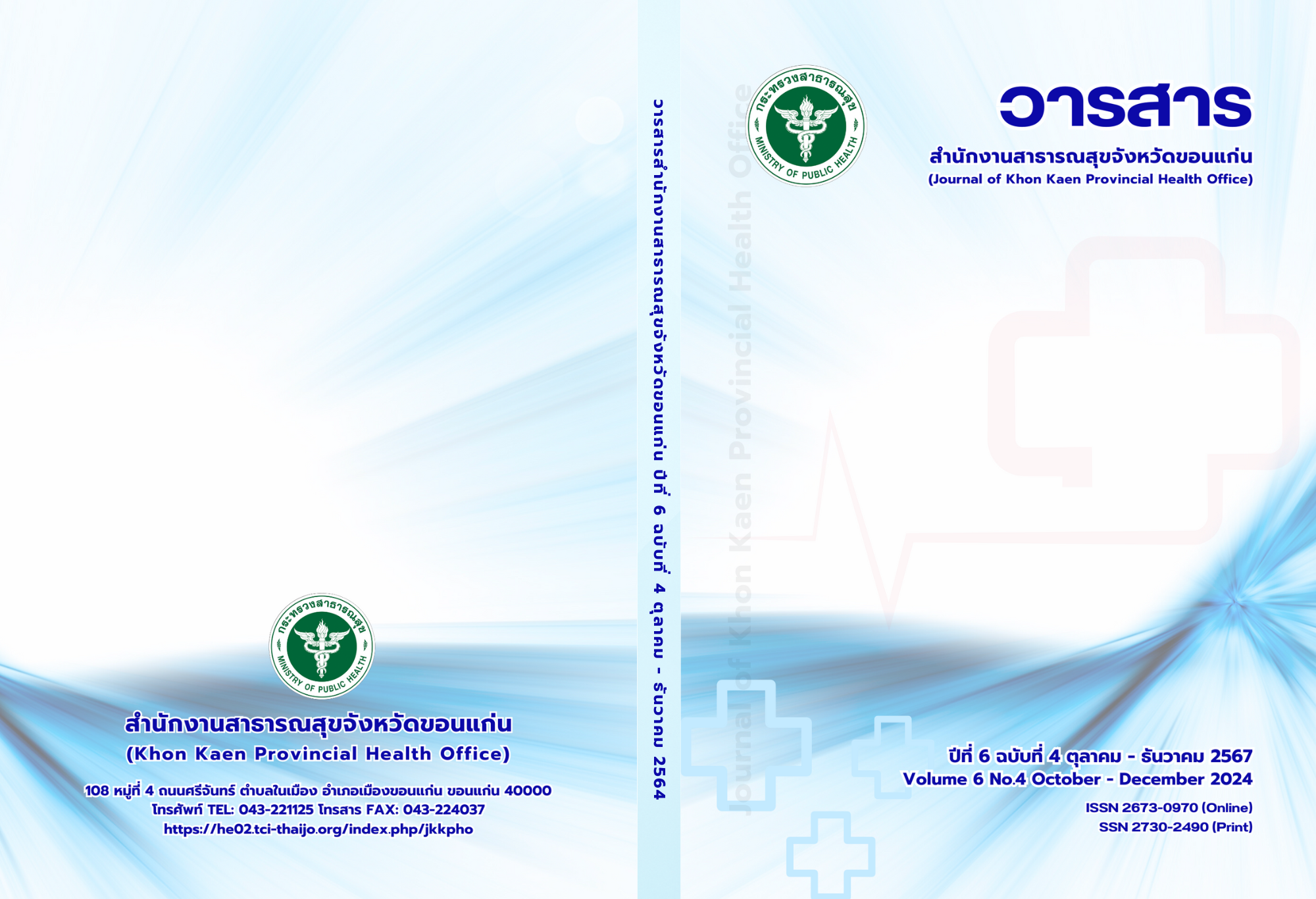อุบัติการณ์และปัจจัยที่มีความสัมพันธ์กับการเกิดเลือดออกในสมองหลังได้รับยาละลายลิ่มเลือดในผู้ป่วยโรคหลอดเลือดสมองที่เข้ารับการรักษาในโรงพยาบาลกาฬสินธุ์ ปีงบประมาณ พ.ศ. 2564-2566
คำสำคัญ:
โรคหลอดเลือดสมอง, เลือดออกในสมอง, ยาละลายลิ่มเลือด, ปัจจัยเสี่ยงบทคัดย่อ
การวิจัยแบบย้อนหลังจากเหตุไปหาผล (Retrospective cohort study) ครั้งนี้ มีวัตถุประสงค์เพื่อศึกษาอุบัติการณ์และปัจจัยที่มีสัมพันธ์กับการเกิดเลือดออกในสมองหลังได้รับยาละลายลิ่มเลือดในผู้ป่วยโรคหลอดเลือดสมองในโรงพยาบาลกาฬสินธุ์ ระหว่างปีงบประมาณ 2564 - 2566 โดยพรรณนาลักษณะผู้ป่วย วิเคราะห์ค่าสัมประสิทธิ์ความสัมพันธ์ของปัจจัยในการศึกษา ทดสอบความแตกต่างระหว่างกลุ่มที่เกิดและไม่เกิดเลือดออกในสมองหลังได้รับยาละลายลิ่มเลือดโดย Chi square หรือ Fisher’s exact test และ Student t-test หรือ Wilcoxon Rank Sum test วิเคราะห์ปัจจัยที่มีสัมพันธ์กับการเกิดภาวะดังกล่าว โดยวิเคราะห์แบบตัวแบบเชิงเส้นนัยทั่วไป (Generalized Linear Model, GLMs) พบว่า อุบัติการณ์การเกิดเลือดออกในสมองหลังได้รับยาละลายลิ่มเลือดของผู้ป่วยโรคหลอดเลือดสมองเท่ากับร้อยละ 12.43 (95% CI: 8.49, 17.38) พบว่าปัจจัยที่มีสัมพันธ์กับการเกิดเลือดออกในสมองหลังได้รับยาละลายลิ่มเลือดในผู้ป่วยโรคหลอดเลือดสมอง อย่างมีนัยสำคัญทางสถิติ ได้แก่ ค่า WBC (ARR= 1.01, 95% CI: 1.01, 1.01) ค่า INR (ARR= 10.50 ,95% CI: 2.07, 53.34) และ คะแนน NIHSS ที่สูงขึ้น (ARR= 1.07,95% CI: 1.01, 1.14)
References
Vos T, Lim SS, Abbafati C, Abbas KM, Abbasi M, Abbasifard M, Abbasi-Kangevari M, Abbastabar H, Abd-Allah F, Abdelalim A, Abdollahi M. Global burden of 369 diseases and injuries in 204 countries and territories, 1990–2019: a systematic analysis for the Global Burden of Disease Study 2019. The Lancet. 2020 Oct 17;396(10258):1204-22.
Healthdata.org [Internet]. Washington: Health research by location; Thailand [cited 2024 Feb 29]. Available from: https://www.healthdata.org/research-analysis/health-by-location/profiles/thailand#main-content
Tiamkao S, Ienghong K, Cheung LW, Celebi I, Suzuki T, Apiratwarakul K. Stroke Incidence, Rate of Thrombolytic Therapy, Mortality in Thailand from 2009 to 2021. Open Access Maced J Med Sci [Internet]. 2022 Jan. 16 [cited 2024 Feb. 29];10(E):110-5. Available from:https://oamjms.eu/index.php/mjms/article/view/8051
Hdcservice.moph.go.th [Internet]. Nonthaburi: กลุ่มรายงานมาตรฐาน, ข้อมูลเพื่อตอบสนอง Service Plan สาขาโรคหัวใจ และหลอดเลือด, อัตราผู้ป่วยรายใหม่จากโรคหลอดเลือดสมอง cited 2024 Feb 29]. Available from: https://hdcservice.moph.go.th/hdc/reports/report.php?cat_id= 39fd60c25235db479930db85a0e97dd3&id=b184366d9fa112292f8374184b21e1a8
วิทยาลัยแพทย์ฉุกเฉินแห่งประเทศไทย. แนวทางการรักษาและให้ยาละลาย
ลิ่มเลือดสำหรับโรคหลอดเลือดสมองตีบเฉียบพลันภายนอกโรงพยาบาลและที่ห้องฉุกเฉินปี พ.ศ. 2563. กรุงเทพมหานคร; 2563.
Honig A, Percy J, Sepehry AA, Gomez AG, Field TS, Benavente OR. Hemorrhagic Transformation in Acute Ischemic Stroke: A Quantitative Systematic Review. J Clin Med. 2022 Feb 22;11(5):1162.
Wang R, Zeng J, Wang F, Zhuang X, Chen X, Miao J. Risk factors of hemorrhagic transformation after intravenous thrombolysis with rt-PA in acute cerebral infarction. QJM. 2019 May 1;112(5):323-6.
Schurig J, Haeusler KG, Grittner U, Nolte CH, Fiebach JB, Audebert HJ, et al. Frequency of Hemorrhage on Follow Up Imaging in Stroke Patients Treated With rt-PA Depending on Clinical Course. Front Neurol. 2019;10:368.
Liu L, Luo GQ, Liu Q, Yang ZY. Hemorrhagic risk factors after rt PA thrombolysis in acute cerebral infarction. Eur Rev Med Pharmacol Sci. 2023 Jun;27(12):5542-51.
Ge WQ, Chen J, Pan H, Chen F, Zhou CY. Analysis of Risk
Factors Increased Hemorrhagic Transformation after Acute Ischemic Stroke. J Stroke Cerebrovasc Dis. 2018 Dec;27(12):3587-90.
Pengtong W, Aimyong N, Nilanont Y. Intracranial hemorrhage after recombinant tissue plasmino- gen Activator: The competing risks survival analysis. Interdiscip Neurosurg. 2023 Jun 1;32:101734.
Lokeskrawee T, Muengtaweepongsa S, Patumanond J, Tiamkao S, Thamangraksat T, Phankhian P, et al. Prediction of Symptomatic Intracranial Hemorrhage after Intravenous Thrombolysis in Acute Ischemic Stroke: The Symptomatic Intracranial Hemorrhage Score. J Stroke Cerebrovasc Dis. 2017 Nov;26(11):2622-9.
Satumanatpan N, Tonpho W, Thiraratananukulchai N, Chaichanamongkol P, Lekcharoen P, Thiankhaw K. Factors Associated with Unfavorable Functional Outcomes After Intravenous Thrombolysis in Patients with Acute Ischemic Stroke. Int J Gen Med. 2022; 15:3363-73.
Vorasoot N, Kasemsap N, Kongbunkiat K, Peansukwech U, Tiamkao S, Sawanyawisuth K. Impact of Hospital Level on Stroke Outcomes in the Thrombolytic Therapy Era in Northeast Thailand: A Retrospective Study. Neurol Ther. 2021 Dec;10(2):727-37.
Maïer B, Desilles JP, Mazighi M. Intracranial Hemorrhage After Reperfusion Therapies in Acute Ischemic Stroke Patients. Front Neurol. 2020;11:599908.
Weir CB, Jan A. BMI Classification Percentile And Cut Off Points [Internet]. 2022 [cited 2024 Oct 20]. Available from:https://europepmc.org/article/nbk/nbk541070#_article-35288_s5_.
สถาบันประสาทวิทยา กรมการแพทย์. แนวทางการรักษาโรคหลอดเลือดสมองตีบหรืออุดตันสำหรับแพทย์ (Clinical Practice Guidelines for Ishemic Stroke) ฉบับสมบูรณ์ 2562. กรุงเทพมหานคร; 2562.
Zhuo Y, Qu Y, Wu J, Huang X, Yuan W, Lee J, et al. Estimation of stroke severity with National Institutes of Health Stroke Scale grading and retinal features: A cross-sectional study. Medicine (Baltimore). 2021 Aug 6;100(31):e26846.
Chompoochan W. Incidence and Risk Factors of Post Thrombolysis Intracranial Hemorrhage in Acute Ischemic Stroke, Bueng Kan Hospital. JPMAT [Internet]. 2024 Oct 20 [cited 2024 Oct. 20];12(1):82-99. Available from: https://he01.tcithaijo.org/index.php/JPMAT/article/view/252306
limsuriyakan wasan, Lorwanich P. Factor related intracerebral hemorrhage of patients With acute ischemic stroke who receive rtPA at Ayutthaya hospital. TUHJ [Internet]. 2024 Oct 20 [cited 2024 Oct. 20];6(1):12-20. Available from: https://he02.tcithaijo.org/index.php/TUHJ/article/view/249063
Dharmasaroja PA, Muengtaweepongsa S, Pattaraarchachai J, Dharmasaroja P. Intracerebral hemorrhage following intravenous thrombolysis in Thai patients with acute ischemic stroke. J Clin Neurosci. 2012 Jun;19(6):799-803.
Okada T, Suzuki H, Travis ZD, Zhang JH. The Stroke-Induced Blood-Brain Barrier Disruption: Current Progress of Inspection Technique, Mechanism, and Therapeutic Target. Curr Neuropharmacol. 2020;18(12):1187-212.
Arba F, Rinaldi C, Caimano D, Vit F, Busto G, Fainardi E. Blood-Brain Barrier Disruption and Hemorrhagic Transformation in Acute Ischemic Stroke: Systematic Review and Meta-Analysis. Front Neurol. 2020; 11:594613.
Altersberger VL, Enz LS, Sibolt G, Hametner C, Nannoni S, Heldner MR, et al. Thrombolysis in stroke patients with elevated inflammatory markers. J Neurol. 2022 Oct;269(10):5405-19.
Yu Z, Zheng J, Guo R, Ma L, You C, Li H. Prognostic impact of leukocytosis in intracerebral hemorrhage: A PRISMA-compliant systematic review and meta-analysis. Medicine (Baltimore). 2019 Jul;98(28): e16281.
Xie J, Pang C, Yu H, Zhang W, Ren C, Deng B. Leukocyte indicators and variations predict worse outcomes after intravenous thrombolysis in patients with acute ischemic stroke. J Cereb Blood Flow Metab. 2023 Mar;43(3):393-403.
Teekaput C, Thiankhaw K, Tanprawate S, Teekaput K, Chai-Adisaksopha C. Outcomes of asymptomatic recombinant tissue plasminogen activator associated intracranial hemorrhage. PLoS One. 2022;17(8):e0272257.
Ruecker M, Matosevic B, Willeit P, Kirchmayr M, Zangerle A, Knoflach M, et al. Subtherapeutic warfarin therapy entails an increased bleeding risk after stroke thrombolysis. Neurology. 2012 Jul 3;79(1):31-8
Downloads
เผยแพร่แล้ว
How to Cite
ฉบับ
บท
License
Copyright (c) 2024 สำนักงานสาธารณสุขจังหวัดขอนแก่น

This work is licensed under a Creative Commons Attribution-NonCommercial-NoDerivatives 4.0 International License.
บทความที่ได้รับการตีพิมพ์เป็นลิขสิทธิ์ของสำนักงานสาธารณสุขจังหวัดขอนแก่น กระทรวงสาธารณสุข
ข้อความที่ปรากฏในบทความแต่ละเรื่องในวารสารวิชาการเล่มนี้เป็นความคิดเห็นส่วนตัวของผู้เขียนแต่ละท่านไม่เกี่ยวข้องกับสำนักงานสาธารณสุขจังหวัดขอนแก่น และบุคลากรท่านอื่นๆในสำนักงานฯ แต่อย่างใด ความรับผิดชอบองค์ประกอบทั้งหมดของบทความแต่ละเรื่องเป็นของผู้เขียนแต่ละท่าน หากมีความผิดพลาดใดๆ ผู้เขียนแต่ละท่านจะรับผิดชอบบทความของตนเองแต่ผู้เดียว


